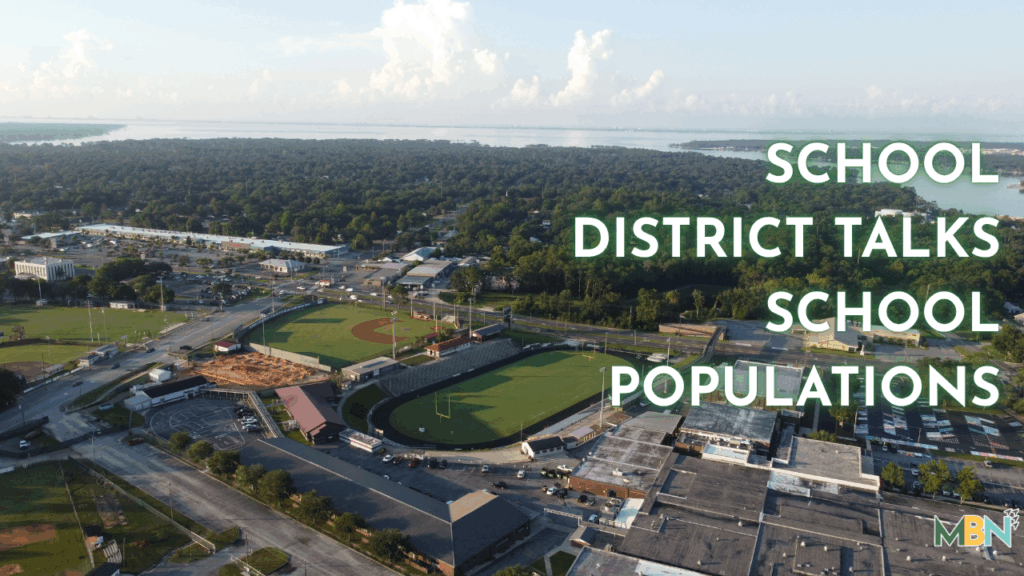
📈 Northern Okaloosa schools are growing fast — while southern campuses lose students
🏫 District may consider boundary changes or consolidations to manage enrollment shifts
💰 Voucher expansion and homeschooling are accelerating public school losses
NICEVILLE — A widening demographic divide between north and south Okaloosa County is reshaping the school district’s enrollment map and could soon force officials to make tough financial and facility decisions.
During an Okaloosa County School Board workshop on Monday, Assistant Superintendent John Spolski outlined data showing steady student growth in the northern part of the county, centered on Crestview, while schools in the South — including Fort Walton Beach, Destin, and Niceville — continue to experience student losses.
“We have a tale of two regions,” Spolski said. “Everything north of the Shoal River is going through enormous growth … and the South is a totally different tale. We’re seeing extreme constriction.”
The district’s long-term projections, developed in collaboration with consulting firm MGT and verified using internal data, indicate that Crestview’s elementary population is expected to increase by 851 students over the next 11 years, representing a rise of approximately 77 students per year across seven elementary schools.
By contrast, elementary schools in the central and southern zones — including areas such as Niceville, Fort Walton Beach, and Destin — are expected to experience a net loss of approximately 1,100 students through 2034.
Even those modest gains in the north mask uneven trends. Spolski said kindergarten enrollment has declined in some Crestview schools, with families opting for homeschooling, private schools, or vouchers under the state’s Family Empowerment Scholarship (FES) program.
“We’re seeing a steady decline in the Fort Walton Beach area elementaries since COVID,” Spolski said. “The green line [for the South Zone] is moving down — quite a drastic dip for only a two- or three-year period.”
The shifting enrollment carries financial consequences. School funding in Florida is directly tied to the number of students enrolled, meaning fewer students result in less revenue for operations, staffing, and maintenance.
Superintendent Marcus Chambers informed board members that the district had anticipated losing roughly 450 students this year, based on state projections. However, the actual loss was closer to 1,000 students once scholarships and demographic changes were factored in.
“That’s close to a thousand students,” Chambers said. “Many districts across the state didn’t expect that kind of addition.”
He added that the district has already adjusted staffing and budget allocations accordingly, working with the finance office to “position ourselves for the dip.”
Board Chair Lamar White reminded colleagues that the math is simple. “You can’t operate a school with empty seats because you don’t have the revenue,” he said.
Chambers said he hopes to present potential recommendations, possibly including consolidations, boundary adjustments, or repurposing facilities, by the December board meeting, though he vowed “not to rush anything.”
Board Member Parker Destin, who represents Destin and Fort Walton Beach, asked whether private and charter schools were seeing similar enrollment declines.
Spolski said they were not. Rocky Bayou Christian School has expanded steadily over the past decade, while Liza Jackson Preparatory School has continued to grow since its new campus was built.
Chambers noted that these schools now benefit directly from the state’s expanded voucher system. “There used to be a percentage of FES dollars going to those schools — that number has risen dramatically,” he said.
Spolski added that Rocky Bayou’s elementary tuition now roughly equals the value of a Family Empowerment Scholarship, making it effectively tuition-free for participating families.
Smaller parochial schools, such as St. Mary’s Catholic School in Fort Walton Beach, have not grown as quickly; however, overall private options are expanding.
Board Member Linda Evanchyk said the district needs to “advertise what is right” — meaning to publicly promote its programs and teachers to families now presented with a range of schooling choices.
“We have so many great things that we need to push out there into the public,” Evanchyk said. “We need to be proactive.”
Spolski said the district has already begun digital outreach and postcard campaigns inviting families to visit campuses and meet principals, especially in older neighborhoods experiencing turnover.
“Families send their kids to schools because of the people and the relationships,” he said. “That’s what they do.”
Chambers closed the meeting by acknowledging that the combination of shrinking enrollment, expanding school-choice options, and rising operating costs will necessitate the district to reassess how it utilizes its facilities.
“We’re blessed with fantastic teachers and an outstanding area where people want to live,” he said. “But it will lead itself to tough decisions that we haven’t had to deal with in a while.”
Officials emphasized that those decisions, expected early next year, will be data-driven and aimed at maintaining strong schools even as Okaloosa’s population shifts northward.
Register or login with Mid Bay News and never get another pop up on our site!